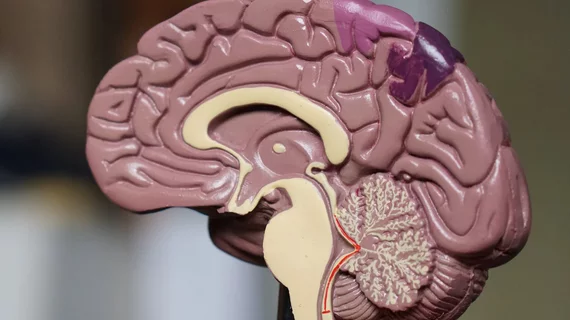A new positron emission tomography radiotracer tested for the first time in patients is effective at imaging common, malignant brain tumors.
That’s what researchers out of Beijing reported during a recent presentation at the Society of Nuclear Medicine and Molecular Imaging 2020 virtual meeting. They tested the radiopharmaceutical—64Cu-EBRGD—in a handful of patients, with no adverse symptoms up to a week after their exams.
With a number of unique qualities, co-researcher Jingjing Zhang, MD, PhD, of Peking Union Medical College Hospital in China, and colleagues say the new material offers “persistent, high-contrast” images in people with glioblastoma.
"In this study, we have demonstrated a potential radiotheranostic agent that is safe, sensitive and highly selective in humans, which infers a future diagnostic tool and breakthrough targeted radiotherapy for glioblastoma patients," Zhang added in a June 13 statement. "We believe this innovative use of 64Cu-EBRGD will significantly improve therapeutic efficacy and patient outcomes."
For the first in-human study, the group enrolled two patients with recurrent glioblastoma and three healthy volunteers who all underwent whole-body 64Cu-EBRGD PET/CT. One day and one week after patients’ exams, clinicians gathered safety data, including: vital signs, physical examination, electrocardiography, laboratory parameters and adverse events, along with other necessary information.
No patients reported adverse symptoms immediately or up to one week after their exams. The radiotracer showed high accumulation at the tumor, with tumor-to-background contrast that increased over time. What’s more, the average effective dose of 64Cu-EBRGD was quite similar to that of an 18F-FDG scan.
Nearly 17,000 cases of glioblastoma are diagnosed each year, and most patients survive less than 15 months. A number of other agents already being tested in various forms of cancer can be switched out for 64Cu-labeled agents, the authors noted, meaning the latter may prove valuable in patients with other forms of the disease.
"64Cu-labeled EBRGD represents a viable model compound for therapeutic applications since 177Lu, 90Y or 225Ac can be substituted for 64Cu," said co-author Deling Li, MD, of Beijing Tiantan Hospital, Capital Medical University, Beijing, China. "We are currently studying the 177Lu homolog to treat glioblastoma and other αvβ3 integrin expressing cancers, including non-small cell lung, melanoma, renal and bone, and hope to build on the current wave of radiotherapies like 177Lu-dotatate."

